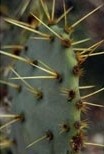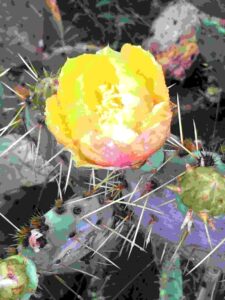Prickly Pear Cactus
by CMG Betty J
One of the most common native plants in the Edwards Plateau region of central Texas is the Prickly Pear Cactus, a variety of members of the Optunia species of cacti. Optunia engelmannii var. engelmannii and Optunia engelmannii var. lindheimeri are the varieties most often encountered in this region. Also known as Cactus Apple, Texas Prickly Pear or Lindheimer Prickly Pear, these attractive natives may grow up to five feet tall and spread in a clump as wide as 12 feet. Their native range extends from Texas to California, north to Utah, and south throughout much of Mexico.
As their name implies, they are thorny plants whose leaves, called pads, are covered in ½” – 4 ½” spines. Different varieties have unique spine patterns. The Texas Prickly Pear has 1-6 yellow spines with one spine growing as long as 4 ½” on its blue-green pads.

Prickly Pear Spines
The spines grow in clusters that are widely spaced on the pads and short yellow to reddish-brown spikes, (glochids), grow in irregular tufts at the base of the clusters. Occasionally an entire plant is spineless.
Prickly Pear flowers are beautiful and showy, appearing in April and May. They grow on the upper edge of the pad and each cup-shaped bloom is 2”-5” wide. Petals vary from yellow to orange to red and the butter-yellow color fades to apricot as they mature. Flowers have one pistil and many yellow stamens. The fruit, called “tuna”, is a barrel-shaped pod 1”-3” long that matures to a dark red color. The tunas are edible although much preparation is required to extract the juice. The pods have both thorns and glochids and the pulp contains many seeds. Still, many Texans make jam and jelly from Prickly Pear juice. The pads are edible, too. Known as nopales and nopalitos, they are often sold prepared and ready to cook in Latin American markets.

Prickly Pear Flower

Prickly Pear Tunas
As part of a xeriscape landscaping or a natural setting, Prickly Pear cacti add a bit of Texas vibe to a yard. Just be sure to locate them where their thorns do not become problematic.